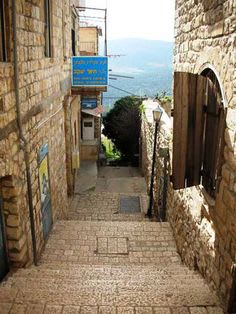Land of My Birth – The sixteenth century was the golden era of Tzefat. At the time, this city in the Galil was the home of the majority and the most prominent of the Jews living in Eretz Yisrael. About 1,000 Jewish families lived there, including the greatest rabbis of the time. The most prominent one was Rabbi Yaakov Beirav, who was educated in Spain but moved to Fez, in Morocco, in 1492 because of the expulsions. There he was appointed a rabbi when he was only 18 years old. He moved to Eretz Yisrael by traveling through Egypt, and he arrived in Tzefat in 1534. His good traits were quickly discovered, and he was appointed to head the community. Rabbi Yosef Karo, who was about ten years younger, called Rabbi Beirav “my great master.” Aside from his great Torah scholarship, Rabbi Beirav was the richest and most respected man in the city.
The relative prosperity of the Jews in Eretz Yisrael in general and in Tzefat in particular gave rise to messianic feelings, and this can help to explain why Rabbi Yaakov Beirav decided to renew the institution of “Semicha,” formal recognition of passing Jewish tradition to specific recognized rabbis. He based his proposal on the words of the Rambam, who ruled that “if all the wise men of Eretz Yisrael decide to appoint judges and to give them approval, these people can be considered as having Semicha” [Hilchot Sanhedrin 4:11]. Twenty-five rabbis of Tzefat, which as noted was the center of the wise men of the land, agreed to his request and signed the daring proposal. Here is part of their formal declaration:
“… and now our G-d has answered our prayers and left us some remnants, letting us live as on this day. And he raised us up from the pits of exile and destruction and brought us to this place (Tzefat) which is linked to His name. We have arisen, and we will gather the strength to be zealous for the glory of G-d and to raise the banner of Torah. We have therefore chosen the greatest from among us in wisdom, the illustrious Rabbi Yaakov Beirav, to receive ‘Semicha,’ and he will invite other wise men to join him. And they will have `Semicha` forever more, acting in truth and justice according to the laws of the Torah. And let this act of charity and peace be the beginning of our salvation, fulfilling the words of His servant, ‘And I will restore your judges as in the beginning’ [Yeshayahu 1:26].”
At first it seemed that the sages of Jerusalem, who were in the minority, accepted this revolutionary move, and in the year 1538 the concept of Semicha was indeed revived. Rabbi Beirav passed the Semicha on to four other rabbis in Tzefat, including Rabbi Yosef Karo. However, Ralbach (Rabbi Levi Ben Chaviv), a famous Torah scholar who led the rabbis of Jerusalem, strongly opposed the daring proposal. The argument was mainly on halachic grounds, but it was also influenced by ideological considerations. Rabbi Yaacov, who lived in the flourishing city of Tzefat, was a master of the Kabbalah, with messianic tendencies. Ralbach, on the other hand, lived in the suppressed city of Jerusalem, and he would sign his name, “he who sighs brokenly when he sees the ruins of the Temple around him.”
The disagreement with the rabbis of Jerusalem was so harsh, involving the government authorities, that Rabbi Yaakov feared for his life, and he was forced to leave Tzefat and move to Damascus. In one of his Responsa, he wrote:
“I am deeply sorry that I was not privileged to fulfill the mitzva of appointing judges who would have been worthy of rejuvenating Yisrael and returning the people to their land. G-d knows that my only intention was in the name of heaven, and not for any purposes of achieving greatness or power.”
The idea of establishing the Sanhedrin rises up now and then, as happened when Israel was established. At the time, the Minister of Religions, Rabbi Yehuda Leib Fishman (Maimon), of the Mizrahi, proposed that the Sanhedrin should be established, based on his belief that we are in the era of “the start of the redemption.” Once again, a halachic-ideological disagreement broke out. The Chazon Ish declared as follows:
“The words of those who refuse to accept the Semicha are clear and correct, while the words of those who propose this concept are beyond comprehension …”
(Source: Moshe David Gaon, “The Jews from the East in Eretz Yisrael”)
Reprinted with permission from Zomet Institute (www.zomet.org.il).
The words of this author reflect his/her own opinions and do not necessarily represent the official position of the Orthodox Union.
